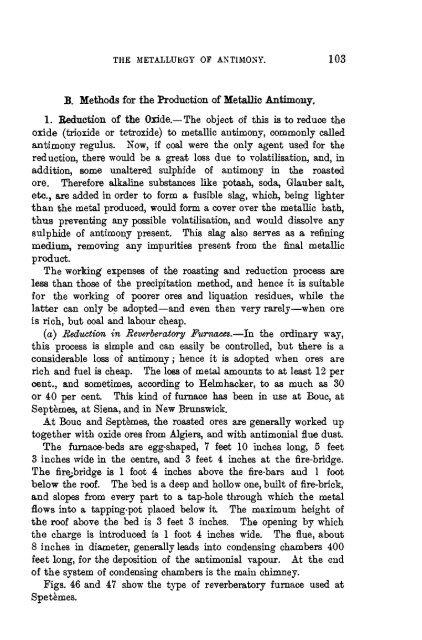antimony - Sciencemadness.org
antimony - Sciencemadness.org
antimony - Sciencemadness.org
Create successful ePaper yourself
Turn your PDF publications into a flip-book with our unique Google optimized e-Paper software.
THE METALLURGY OF ANTIMONY. 103<br />
B. Methods for the Production of Metallic Antimony.<br />
1. Eeduction of the Oxide.—The object of this is to reduce the<br />
oxide (trioxide or tetroxide) to metallic <strong>antimony</strong>, commonly called<br />
<strong>antimony</strong> regulus. Now, if coal were the only agent used for the<br />
reduction, there would be a great loss due to volatilisation, and, in<br />
addition, some unaltered sulphide of <strong>antimony</strong> in the roasted<br />
ore. Therefore alkaline substances like potash, soda, Glauber salt,<br />
etc., are added in order to form a fusible slag, which, being lighter<br />
than the metal produced, would form a cover over the metallic bath,<br />
thus preventing any possible volatilisation, and would dissolve any<br />
sulphide of <strong>antimony</strong> present. This slag also serves as a refining<br />
medium, removing any impurities present from the final metallic<br />
product.<br />
The working expenses of the roasting and reduction process are<br />
less than those of the precipitation method, and hence it is suitable<br />
for the working of poorer ores and liquation residues, while the<br />
latter can only be adopted—and even then very rarely—when ore<br />
is rich, but coal and labour cheap.<br />
(a) Reduction in Reverberatory Furnaces.—In the ordinary way,<br />
this process is simple and can easily be controlled, but there is a<br />
considerable loss of <strong>antimony</strong>; hence it is adopted when ores are<br />
rich and fuel is cheap. The loss of metal amounts to at least 12 per<br />
cent., and sometimes, according to Helmhacker, to as much as 30<br />
or 40 per cent. This kind of furnace has been in use at Bouc, at<br />
Septemes, at Siena, and in New Brunswick.<br />
At Bouc and Septemes, the roasted ores are generally worked up<br />
together with oxide ores from Algiers, and with antimonial flue dust.<br />
The furnace-beds are egg-shaped, 7 feet 10 inches long, 5 feet<br />
3 inches wide in the centre, and 3 feet 4 inches at the fire-bridge.<br />
The fire-bridge is 1 foot 4 inches above the fire-bars and 1 foot<br />
below the roof. The bed is a deep and hollow one, built of fire-brick,<br />
and slopes from every part to a tap-hole through which the metal<br />
flows into a tapping-pot placed below it. The maximum height of<br />
the roof above the bed is 3 feet 3 inches. The opening by which<br />
the charge is introduced is 1 foot 4 inches wide. The flue, about<br />
8 inches in diameter, generally leads into condensing chambers 400<br />
feet long, for the deposition of the antimonial vapour. At the end<br />
of the system of condensing chambers is the main chimney.<br />
Figs. 46 and 47 show the type of reverberatory furnace used at<br />
Spetemes.
















